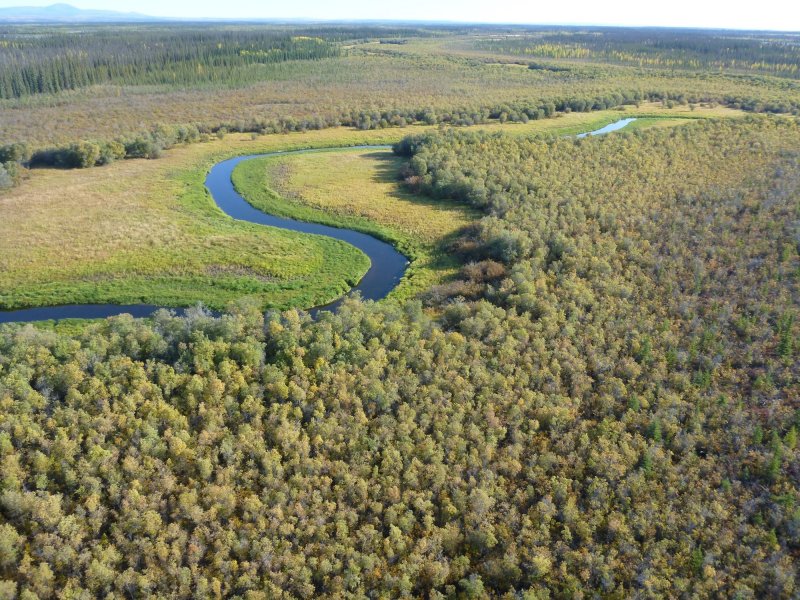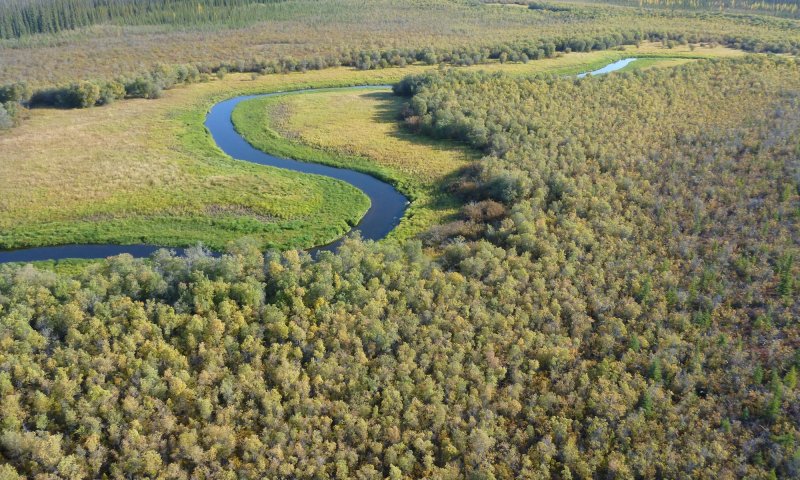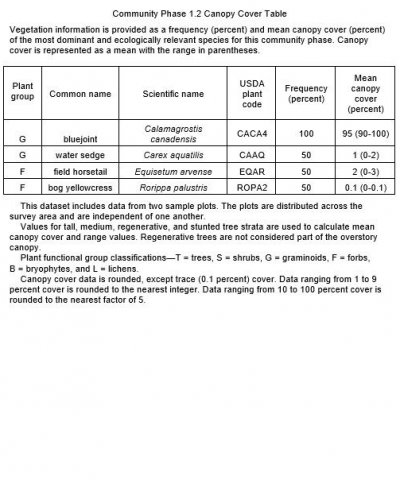

Natural Resources
Conservation Service
Ecological site XA232X01Y280
Boreal Scrub Loamy Flood Plain Wet
Last updated: 5/18/2020
Accessed: 12/20/2025
General information
Provisional. A provisional ecological site description has undergone quality control and quality assurance review. It contains a working state and transition model and enough information to identify the ecological site.
MLRA notes
Major Land Resource Area (MLRA): 232X–Yukon Flats Lowlands
The Yukon Flats Lowlands MLRA is an expansive basin characterized by numerous levels of flood plains and terraces that are separated by minimal breaks in elevation. This MLRA is in Interior Alaska and is adjacent to the middle reaches of the Yukon River. Numerous tributaries of the Yukon River are within the Yukon Flats Lowlands MLRA. The largest are Beaver Creek, Birch Creek, Black River, Chandalar River, Christian River, Dall River, Hadweenzic River, Hodzana River, Porcupine River, and Sheenjek River. The MLRA has two distinct LRU—lowlands and marginal uplands. The lowlands have minimal local relief and are approximately 9,000 square miles in size (Williams 1962). Landforms associated with the lowlands are flood plains and stream terraces. The marginal uplands consist of rolling and dissected plains that are a transitional area between the lowlands and adjacent mountain systems. The marginal uplands are approximately 4,700 square miles in size (Williams 1962).
This MLRA is bounded by the Yukon-Tanana Plateau to the south, Hodzana Highlands to the west, Porcupine Plateau to the east, and southern foothills of the Brooks Range to the north (Williams 1962). These surrounding hills and mountains partially isolate the Yukon Flats Lowlands MLRA from weather systems affecting other MLRAs of Interior Alaska. As a result, temperatures are generally warmer in summer and colder in winter than is characteristic in other areas at comparable latitude. There is a moisture and temperature gradient in which the lowlands region tends to be drier and colder and the surrounding marginal uplands region tends to be moister and warmer (PRISM Climate Group 2006).
The Yukon Flats Lowlands MLRA is mostly undeveloped lands that are sparsely populated and not accessible by a road system. A number of villages, including Beaver, Birch Creek, Chalkyitsik, Circle, Fort Yukon, Stevens Village, and Venetie, are adjacent to the Yukon River or one of its major tributaries. The largest village is Fort Yukon, which according to the 2010 U.S. Census has 583 residents that are dominantly Gwich’in Alaska Natives.
LRU notes
Alaska has no officially recognized LRU. However, there appear to be two distinct LRU in the Yukon Flats Lowlands MLRA. These LRU are thought to have differing climatic regimes, landforms, and soil types (STATSGO and Jorgensen and Meidinger 2015). The two LRU were previously discussed in the MLRA notes section above and are termed the lowlands LRU and the marginal uplands LRU.
This ecological site is associated with the lowlands LRU.
Classification relationships
Yukon Flats Lowlands MLRA.
Ecological site concept
This ecological site is associated with the flood plain and adjacent terraces of minor, low-gradient tributaries in the Yukon Flats Lowlands MLRA. The reference plant community is associated with soils that both pond and flood. Ponding occurs frequently (greater than 50 times in 100 years) for long durations of time (between 7 and 30 days). Flooding occurs occasionally (5 to 50 times in 100 years) for brief durations of time (between 2 and 7 days). The reference state supports three plant communities, which represent riparian primary succession along these minor tributaries.
The reference plant community phase is characterized as closed tall scrub (greater than 75 percent shrub cover; Viereck et al. 1992) primarily composed of a mixture of willow (Salix spp.). Commonly observed species include tealeaf willow (Salix pulchra), littletree willow (Salix arbusculoides), Bebb willow (Salix bebbiana), sweetgale (Myrica gale), bluejoint (Calamagrostis canadensis), water sedge (Carex aquatilis), and field horsetail (Equisetum arvense).
Associated sites
| XA232X01Y205 |
Boreal Grass Loamy Flood Plain Depressions This ecological site is associated with depressions on flood plains in the Yukon Flats Lowlands MLRA. The reference state plant communities are associated with soils that both pond and flood. Ponding occurs occasionally (5 to 50 times in 100 years) for brief durations of time (between 2 and 7 days). Flooding occurs occasionally for brief durations of time. The reference plant community is characterized as open tall scrub (Viereck et al. 1992) and is primarily composed of willow (Salix spp.). |
|---|---|
| XA232X01Y206 |
Boreal Scrub Loamy Frozen Flood Plain Depressions This ecological site is associated with depressions on flood plains in the Yukon Flats Lowlands MLRA. The reference state plant communities are associated with soils that both pond and flood. Ponding occurs frequently (greater than 50 times in 100 years) for long durations of time (between 7 and 30 days). Flooding occurs occasionally (5 to 50 times in 100 years) for brief durations of time (between 2 and 7 days). The reference plant community is characterized as mesic graminoid herbaceous (Viereck et al. 1992) and is primarily composed of bluejoint (Calamagrostis canadensis). |
| XA232X01Y219 |
Boreal Forest Loamy Terraces Moist This ecological site is associated with somewhat poorly to moderately well drained soils on the treads of stream terraces in the Yukon Flats Lowlands MLRA. Flooding frequency ranges from rare to none. The reference plant community is characterized as an open needleleaf forest (25 to 60 percent cover) primarily composed of mature white spruce (Picea glauca). |
| XA232X01Y221 |
Boreal Forest Loamy Terraces This ecological site is associated with moderately well to well drained soils on the tread of stream terraces in the Yukon Flats Lowlands MLRA. Flooding frequency ranges from rare to none. The reference plant community is characterized as an open needleleaf forest (25 to 60 percent cover) primarily composed of mature white spruce (Picea glauca). |
| XA232X01Y222 |
Boreal Graminoid Loamy Terrace Depressions This ecological site is associated with closed depressions of stream terraces that support a reference state with multiple graminoid-dominant community phases. These depressions are considered closed because they are not associated with a flood regime and have limited, if any, groundwater flow or recharge. The presumed hydrological inputs for this ecological site are primarily thaw of the annual active soil layer and/or permafrost, snowmelt runoff, and precipitation. This hydrologic regime results in the development of sodic soil properties. |
| XA232X01Y223 |
Boreal Scrub Loamy Frozen Terrace Depressions This shrubby ecological site occurs in the transitional area between the forested tread of a stream terrace and the graminoid-dominant communities associated with closed, terrace depressions (ecological site R232XY222AK). This site typically occurs between the outer third and lip of these closed depressions. The reference plant community for ecological site is characterized as an open tall scrubland (Viereck et al. 1992) and those shrubs are primarily an assortment of willow (Salix spp.). |
Similar sites
| XA232X01Y205 |
Boreal Grass Loamy Flood Plain Depressions Ecological site XA232X01Y205 supports a bluejoint dominant reference plant community similar to community 1.2 of this ecological site. With that said, XA232X01Y205 occurs in flood plain depressions. These ecological sites were kept as unique concepts based on differences in landform position, soils, associated ecological sites, and disturbance regimes. |
|---|---|
| XA232X01Y200 |
Boreal Scrub Loamy Flood Plain Low XA232X01Y200 is associated with the low flood plain of major tributaries. When compared to XA232X01Y280, associated soils do not pond and are comparatively drier. |
| XA232X01Y206 |
Boreal Scrub Loamy Frozen Flood Plain Depressions XA232X01Y206 occurs on the edge of flood plain depressions. This ecological site is commonly associated with permafrost. |
| XA232X01Y223 |
Boreal Scrub Loamy Frozen Terrace Depressions XA232X01Y223 occurs on the edge of terrace depressions. This ecological sites is commonly associated with permafrost. |

Figure 1. The reference plant community for XA232X01Y205 is similar to community 1.2 for ecological site XA232X01Y280. Both are bluejoint dominant communities.
Table 1. Dominant plant species
| Tree |
Not specified |
|---|---|
| Shrub |
(1) Salix |
| Herbaceous |
(1) Calamagrostis canadensis |
Legacy ID
R232XY280AK
Click on box and path labels to scroll to the respective text.











